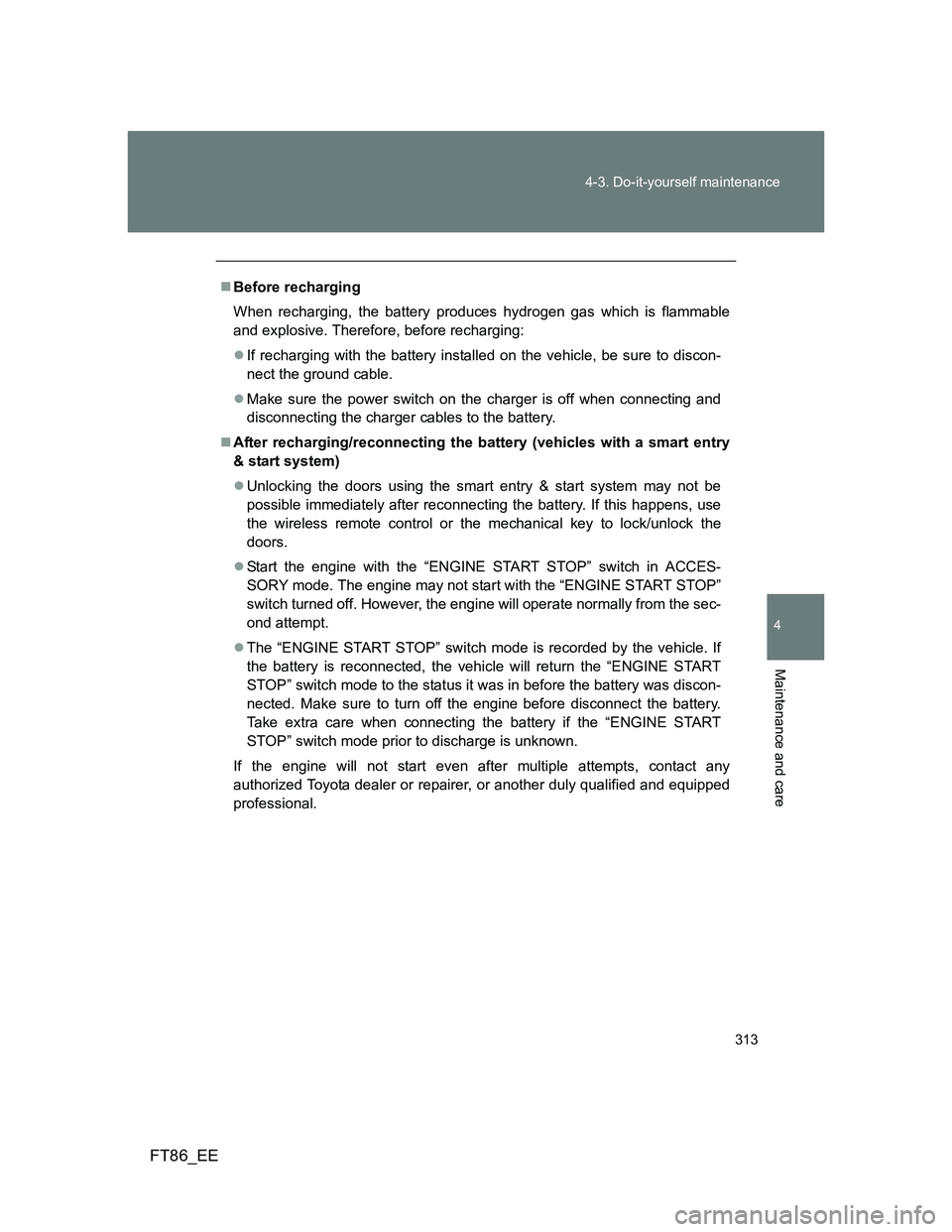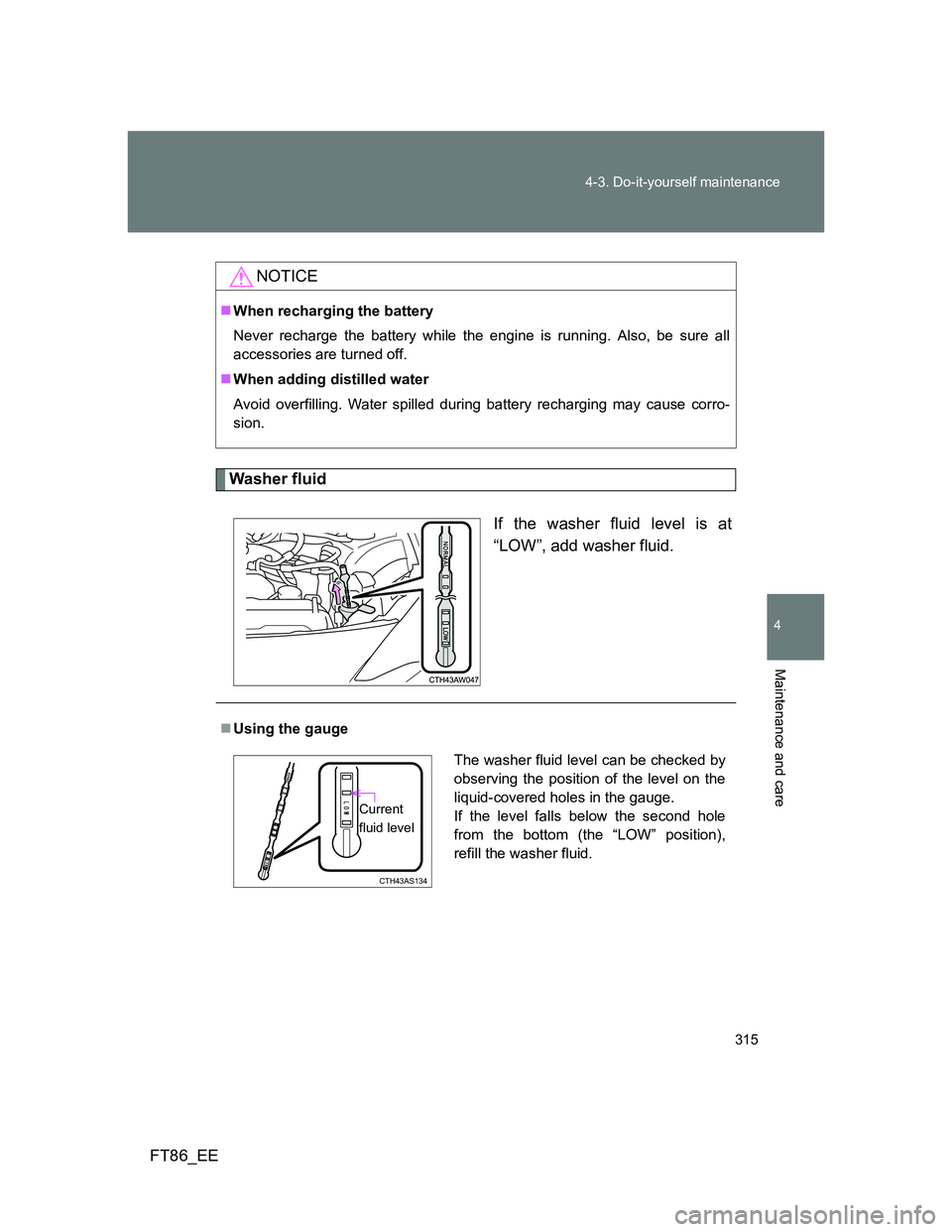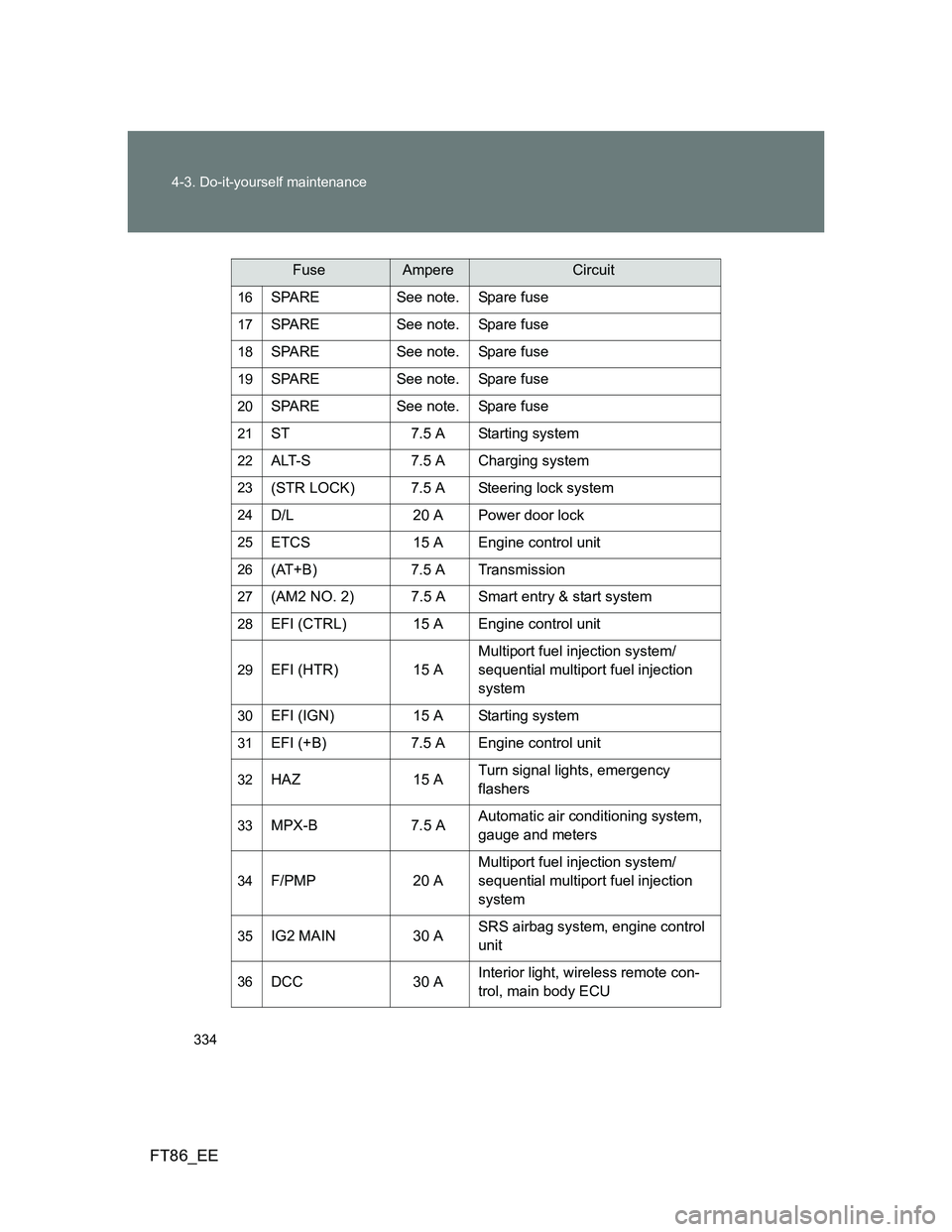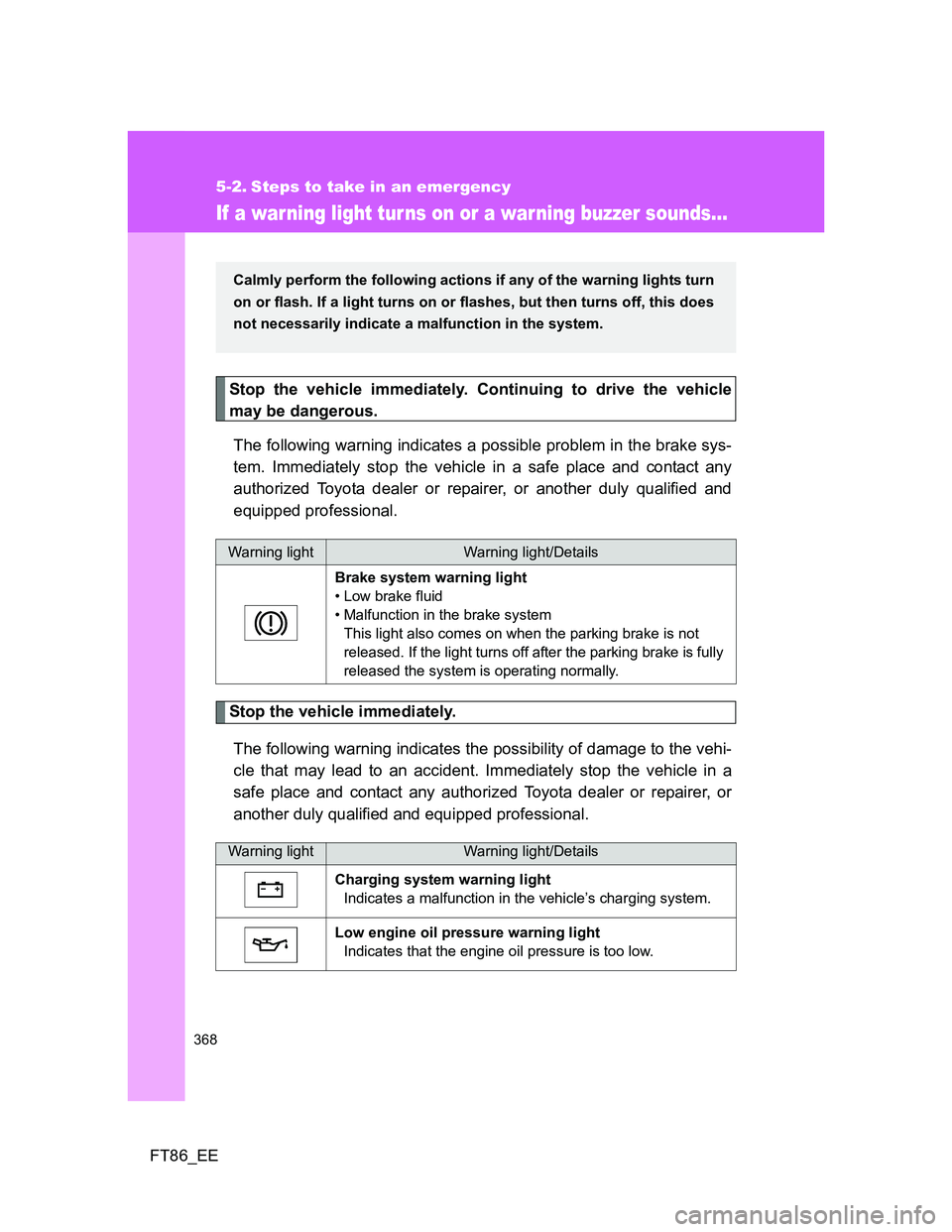2014 TOYOTA GT86 charging
[x] Cancel search: chargingPage 42 of 452

42 1-2. Opening, closing and locking the doors and trunk
FT86_EE
Electronic key battery depletion
The standard battery life is 1 to 2 years.
If the battery becomes low, an alarm will sound in the cabin when the
engine stops. (P. 373)
As the electronic key always receives radio waves, the battery will
become depleted even if the electronic key is not used. The following
symptoms indicate that the electronic key battery may be depleted.
Replace the battery when necessary. (P. 326)
• The smart entry & start system or the wireless remote control does not
operate.
• The detection area becomes smaller.
• The LED indicator on the key surface does not turn on.
To avoid serious deterioration, do not leave the electronic key close to
any of the following electrical appliances that produce a magnetic field:
•TVs
• Personal computers
• Cellular phones, cordless phones and battery chargers
• Recharging cellular phones or cordless phones
• Induction cookers
• Table lamps
When the electronic key battery is fully depleted
P. 326
If the smart entry & start system has been deactivated in a customized
setting
Locking and unlocking the doors, unlocking the trunk: Use the wireless
remote control or mechanical key. (P. 49, 405)
Starting the engine and changing “ENGINE START STOP” switch
modes: P. 406
Stopping the engine: P. 408
Customization that can be configured at any authorized Toyota dealer
or repairer, or another duly qualified and equipped professional
Settings (e. g. smart entry & start system) can be changed.
(Customizable features: P. 437)
Page 313 of 452

313 4-3. Do-it-yourself maintenance
4
Maintenance and care
FT86_EE
Before recharging
When recharging, the battery produces hydrogen gas which is flammable
and explosive. Therefore, before recharging:
If recharging with the battery installed on the vehicle, be sure to discon-
nect the ground cable.
Make sure the power switch on the charger is off when connecting and
disconnecting the charger cables to the battery.
After recharging/reconnecting the battery (vehicles with a smart entry
& start system)
Unlocking the doors using the smart entry & start system may not be
possible immediately after reconnecting the battery. If this happens, use
the wireless remote control or the mechanical key to lock/unlock the
doors.
Start the engine with the “ENGINE START STOP” switch in ACCES-
SORY mode. The engine may not start with the “ENGINE START STOP”
switch turned off. However, the engine will operate normally from the sec-
ond attempt.
The “ENGINE START STOP” switch mode is recorded by the vehicle. If
the battery is reconnected, the vehicle will return the “ENGINE START
STOP” switch mode to the status it was in before the battery was discon-
nected. Make sure to turn off the engine before disconnect the battery.
Take extra care when connecting the battery if the “ENGINE START
STOP” switch mode prior to discharge is unknown.
If the engine will not start even after multiple attempts, contact any
authorized Toyota dealer or repairer, or another duly qualified and equipped
professional.
Page 315 of 452

315 4-3. Do-it-yourself maintenance
4
Maintenance and care
FT86_EE
Washer fluid
If the washer fluid level is at
“LOW”, add washer fluid.
NOTICE
When recharging the battery
Never recharge the battery while the engine is running. Also, be sure all
accessories are turned off.
When adding distilled water
Avoid overfilling. Water spilled during battery recharging may cause corro-
sion.
Using the gauge
The washer fluid level can be checked by
observing the position of the level on the
liquid-covered holes in the gauge.
If the level falls below the second hole
from the bottom (the “LOW” position),
refill the washer fluid.
CTH43AS134
Current
fluid level
Page 334 of 452

334 4-3. Do-it-yourself maintenance
FT86_EE
16SPARE See note. Spare fuse
17SPARE See note. Spare fuse
18SPARE See note. Spare fuse
19SPARE See note. Spare fuse
20SPARE See note. Spare fuse
21ST 7.5 A Starting system
22ALT-S 7.5 A Charging system
23(STR LOCK) 7.5 A Steering lock system
24D/L 20 A Power door lock
25ETCS 15 A Engine control unit
26(AT+B) 7.5 A Transmission
27(AM2 NO. 2) 7.5 A Smart entry & start system
28EFI (CTRL) 15 A Engine control unit
29EFI (HTR) 15 AMultiport fuel injection system/
sequential multiport fuel injection
system
30EFI (IGN) 15 A Starting system
31EFI (+B) 7.5 A Engine control unit
32HAZ 15 ATurn signal lights, emergency
flashers
33MPX-B 7.5 AAutomatic air conditioning system,
gauge and meters
34F/PMP 20 AMultiport fuel injection system/
sequential multiport fuel injection
system
35IG2 MAIN 30 ASRS airbag system, engine control
unit
36DCC 30 AInterior light, wireless remote con-
trol, main body ECU
FuseAmpereCircuit
Page 368 of 452

368
FT86_EE
5-2. Steps to take in an emergency
If a war ning light tur ns on or a warning buzzer sounds...
Stop the vehicle immediately. Continuing to drive the vehicle
may be dangerous.
The following warning indicates a possible problem in the brake sys-
tem. Immediately stop the vehicle in a safe place and contact any
authorized Toyota dealer or repairer, or another duly qualified and
equipped professional.
Stop the vehicle immediately.
The following warning indicates the possibility of damage to the vehi-
cle that may lead to an accident. Immediately stop the vehicle in a
safe place and contact any authorized Toyota dealer or repairer, or
another duly qualified and equipped professional.
Warning lightWarning light/Details
Brake system warning light
• Low brake fluid
• Malfunction in the brake system
This light also comes on when the parking brake is not
released. If the light turns off after the parking brake is fully
released the system is operating normally.
Warning lightWarning light/Details
Charging system warning light
Indicates a malfunction in the vehicle’s charging system.
Low engine oil pressure warning light
Indicates that the engine oil pressure is too low.
Calmly perform the following actions if any of the warning lights turn
on or flash. If a light turns on or flashes, but then turns off, this does
not necessarily indicate a malfunction in the system.
Page 411 of 452

5
411 5-2. Steps to take in an emergency
When trouble arises
FT86_EE
Starting the engine when the battery is discharged
The engine cannot be started by push-starting.
Avoiding a discharged battery
Turn off the headlights and the air conditioning system while the engine is
off.
Turn off any unnecessary electrical components when the vehicle is run-
ning at a low speed for an extended period, such as in heavy traffic, etc.
Charging the battery
The electricity stored in the battery will discharge gradually even when the
vehicle is not in use, due to natural discharge and the draining effects of cer-
tain electrical appliances. If the vehicle is left for a long time, the battery may
discharge, and the engine may be unable to start. (The battery recharges
automatically during driving.)
Precautions when the battery is discharged (vehicles with a smart
entry & start system)
In some cases, it may not be possible to unlock the doors using the smart
entry & start system when the battery is discharged. Use the wireless
remote control or the mechanical key to lock or unlock the doors.
The engine may not start on the first attempt after the battery has
recharged but will start normally after the second attempt. This is not a
malfunction.
Once the vehicle’s engine has started, remove the jumper
cables in the exact reverse order in which they were con-
nected.
Once the engine starts, have the vehicle checked at any autho-
rized Toyota dealer or repairer, or another duly qualified and
equipped professional as soon as possible.STEP 5
Page 430 of 452

430 6-1. Specifications
FT86_EE
Electrical system
Differential
*: Your Toyota vehicle is filled with “Toyota Genuine Differential Gear Oil” at the
factory. Use Toyota approved “Toyota Genuine Differential Gear Oil” or an
equivalent of matching quality to satisfy the above specification. Please con-
tact any authorized Toyota dealer or repairer, or another duly qualified and
equipped professional for further details.
Battery
Specific gravity reading at
20C (68F):1.250 1.290 Fully charged
1.160 1.200 Half charged
1.060 1.100 Discharged
Charging rates
Quick charge
Slow charge15 A max.
5 A max.
Oil capacity (Reference) 1.15 L (1.22 qt., 1.01 Imp. qt.)
Oil type and viscosity*Without LSD
• Toyota Genuine Differential Gear
Oil LT
• Other gear oil that meets API GL-5
and SAE 75W-85 or GL-5 and SAE
75W-90 specifications
With LSD
• Toyota Genuine Differential Gear
Oil LX
• Other gear oil that meets API GL-5
and SAE 75W-85 or GL-5 and SAE
75W-90 specifications
Page 449 of 452

449 Alphabetical index
FT86_EE
Warning buzzers
Electric power steering.......... 369
Seat belt reminder................. 371
Warning lights
Automatic headlight
leveling system ................... 369
Automatic transmission
fluid temperature
warning light ....................... 371
Anti-lock brake system .......... 369
Brake assist system .............. 369
Brake system ........................ 368
Charging system ................... 368
Cruise control
indicator light ...................... 369
Electric power steering
system warning light ........... 369
Electronic engine control
system ................................ 369
Engine oil pressure ............... 368
Low fuel level ........................ 371
Malfunction indicator lamp .... 369
Open door ............................. 371
Pretensioners ........................ 369
Seat belt reminder light ......... 371
Slip indicator light .................. 369
Smart entry & start
system ........................ 369, 373
SRS airbags .......................... 369
Washer
Checking ............................... 315
Preparing and checking
before winter ....................... 236
Switch ................................... 220Washing and waxing ............... 284
Wheels ...................................... 322
Window glasses ........................ 81
Window lock switch .................. 81
Windows
Power windows ....................... 81
Rear window defogger .......... 258
Washer ................................. 220
Windshield wipers ................... 220
Wireless remote control key
Locking/Unlocking................... 49
Replacing the battery ............ 326
Wireless remote control key ... 49W